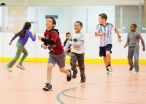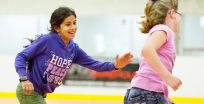(Press-News.org) CHAMPAIGN, Ill. — A nine-month-long, randomized controlled trial involving 221 prepubescent children found that those who engaged in moderate-to-vigorous physical activity for at least 60 minutes a day after school saw substantial improvements in their ability to pay attention, avoid distraction and switch between cognitive tasks, researchers report in the journal Pediatrics.
Half of the study subjects were randomly assigned to the after-school program and the rest were placed on a wait list. All participants underwent cognitive testing and brain imaging before and after the intervention.
"Those in the exercise group received a structured intervention that was designed for the way kids like to move," said University of Illinois kinesiology and community health professor Charles Hillman, who led the study. "They performed short bouts of exercise interspersed with rest over a two-hour period."
The intervention, called FITKids, was based on the CATCH exercise program, a research-based health promotion initiative that was initially funded by the National Institutes of Health and now is used by schools and health departments across the U.S.
The children in the FITKids exercise group wore heart-rate monitors and pedometers during the intervention.
"On average, kids' heart rates corresponded with a moderate-to-vigorous level of exercise intensity, and they averaged about 4,500 steps during the two-hour intervention," Hillman said. The children were active about 70 minutes per day.
As expected, fitness increased most in the intervention group over the course of the study.
"We saw about a six percent increase in fitness in children in the FITKids intervention group," Hillman said. Fitness improved less than one percent in the wait-list control group, he said.
Children in the exercise group also demonstrated substantial increases in "attentional inhibition," a measure of their ability to block out distractions and focus on the task at hand. And they improved in "cognitive flexibility," which involves switching between intellectual tasks while maintaining speed and accuracy. Children in the wait-list control group saw minimal improvements in these measures, in line with what would be expected as a result of normal maturation over the nine months, Hillman said.
"Kids in the intervention group improved two-fold compared to the wait-list kids in terms of their accuracy on cognitive tasks," he said. "And we found widespread changes in brain function, which relate to the allocation of attention during cognitive tasks and cognitive processing speed. These changes were significantly greater than those exhibited by the wait-list kids.
"Interestingly, the improvements observed in the FITKids intervention were correlated with their attendance rate, such that greater attendance was related to greater change in brain function and cognitive performance," Hillman said.
The study did not distinguish improvements that were the result of increased fitness from those that might stem from the social interactions, stimulation and engagement the children in the intervention group experienced, Hillman said.
"Other research at Georgia Regents University led by Catherine Davis has actually used social and game-playing as their control group, and showed that the cognitive effects of their physical activity intervention are above-and-beyond those that are gained just through social interactions," he said.
The FITKids program is designed to get children socially engaged in exercise, which is part of what makes it an effective intervention, Hillman said.
"The fact is that kids are social beings; they perform physical activity in a social environment," he said. "A big reason why kids participate in a structured sports environment is because they find it fun and they make new friends. And this intervention was designed to meet those needs as well."
INFORMATION:
The Eunice Kennedy Shriver National Institute of Child Health and Human Development at the National Institutes of Health funded this research.
Editor's notes:
To reach Charles Hillman, call 217-244-2663; email chhillma@illinois.edu.
The paper, "Effects of the FITKids Randomized Controlled Trial on Executive Control and Brain Function," is available from the U. of I. News Bureau.
After-school exercise program enhances cognition in 7-, 8- and 9-year-olds
2014-09-29
ELSE PRESS RELEASES FROM THIS DATE:
Hand size appears to stay constant, providing natural 'ruler'
2014-09-29
People tend to perceive their dominant hand as staying relatively the same size even when it's magnified, lending support to the idea that we use our hand as a constant perceptual "ruler" to measure the world around us. The findings are published in Psychological Science, a journal of the Association for Psychological Science.
"These findings suggest that our bodies are used as perceptual metrics, meaning that we are more likely to attribute changes in the perceived size of the hand to changes in the world — instead of thinking that our hand has become bigger, we're more ...
More children admitted to intensive care but with lower staffing ratios
2014-09-29
More children than ever are being admitted to intensive care units in England and Wales but there are fewer staff per bed available to cope with the increase, according to a new report published jointly by the University of Leeds and University of Leicester.
The Paediatric Intensive Care Audit Network (PICANet) report showed that there was a 15% increase in admissions over a 10-year period between 2004 and 2013, but this included an increase of 4% that was not due to changes in the childhood population.
At the same time, staffing levels have increased by 36% but this ...
Researchers identify early sign of pancreatic cancer
2014-09-28
BOSTON –– Scientists at Dana-Farber Cancer Institute, the Massachusetts Institute of Technology, and other institutions have discovered a sign of the early development of pancreatic cancer – an upsurge in certain amino acids that occurs before the disease is diagnosed and symptoms appear. The research is being published online today by the journal Nature Medicine.
Although the increase isn't large enough to be the basis of a new test for early detection of the disease, the findings will help researchers better understand how pancreatic cancer affects the rest of the body, ...
Human genome was shaped by an evolutionary arms race with itself
2014-09-28
New findings by scientists at the University of California, Santa Cruz, suggest that an evolutionary arms race between rival elements within the genomes of primates drove the evolution of complex regulatory networks that orchestrate the activity of genes in every cell of our bodies.
The arms race is between mobile DNA sequences known as "retrotransposons" (a.k.a. "jumping genes") and the genes that have evolved to control them. The UC Santa Cruz researchers have, for the first time, identified genes in humans that make repressor proteins to shut down specific jumping ...
Docetaxel or pemetrexed with cisplatin achieve comparable outcomes in non-squamous Lu Ca
2014-09-27
The first direct comparison of treating non-squamous lung cancer with either pemetrexed or docetaxel in addition to cisplatin has shown that the two combinations achieve similar progression-free survival, although docetaxel was associated with more frequent adverse events.
At the ESMO 2014 Congress in Madrid, Dr Young-Chul Kim from Chonnam National University Medical School, South Korea, reported the results of an open-label phase III trial that included 149 patients with non-squamous non-small cell lung cancer (NSCLC) conducted at 14 centres in South Korea.
"We wanted ...
Customising chemotherapy in Lu Ca: New Ph II data reported in 2 LB studies
2014-09-27
Measuring the expression levels of an enzyme involved in DNA synthesis can help predict the response of lung cancers to certain treatments, a Korean study has shown at the ESMO 2014 Congress in Madrid.
In a randomized phase II study, researchers showed that patients whose lung cancers expressed low levels of an enzyme called thymidylate synthase experienced a greater benefit from treatment with the combination of pemetrexed and cisplatin than those whose tumours expressed high levels.
"Thymidylate synthase is one of the proteins that is targeted by pemetrexed which ...
French studies measure benefits of colorectal cancer screening
2014-09-27
The introduction of biennial colorectal cancer screening in a region of France increased the rate of diagnosis of high risk pre-cancerous adenomas (sometimes called polyps) by 89%, researchers have reported at the ESMO 2014 Congress in Madrid.
Dr Vanessa Cottet from INSERM Unité 866 in Dijon, France, and colleagues studied the region of Côte-d'Or, where a registry has been collecting data on adenomas since 1976. They wanted to evaluate the rate of diagnosis of adenomas before and after the initiation of a screening program using fecal occult blood testing that began ...
Crizotinib treatment effective against ROS1-positive lung cancer
2014-09-27
Treatment with the targeted therapy drug crizotinib effectively halts the growth of lung tumors driven by rearrangements of the ROS1 gene. In an article receiving Online First publication in the New England Journal of Medicine to coincide with a presentation at the European Society for Medical Oncology meeting, an international research team reports that crizotinib treatment led to significant tumor shrinkage in 36 of 50 study participants and suppressed tumor growth in another 9.
"Prior to this study, there were a handful of reports describing marked responses to crizotinib ...
Cancer during pregnancy: Chemotherapy and radiotherapy are safe for babies, studies show
2014-09-27
Children who are exposed to chemotherapy or radiotherapy while in the womb suffer no negative impacts on mental or cardiac development, international studies presented at the ESMO 2014 Congress in Madrid have shown.
"When chemotherapy is administered after the first trimester of pregnancy, we cannot discern any problems in the children," says lead author Dr Frederic Amant, KU Leuven and University Hospitals Leuven in Belgium. "Fear about the risks of chemotherapy administration should not be a reason to terminate a pregnancy, delay cancer treatment for the mother, or ...
Anamorelin improve appetite and body mass in patients with cancer anorexia-cachexia
2014-09-27
A new drug, anamorelin, improves appetite and body mass in patients with advanced lung cancer who are suffering cancer anorexia and cachexia, according to phase III data presented at the ESMO 2014 Congress in Madrid, Spain.
"Anorexia and cachexia are among the most troubling and distressing symptoms of advanced cancer, for both patients and their families," says the study's principal investigator, Dr Jennifer Temel from the Department of Medicine, Massachusetts General Hospital, Boston, USA.
Symptoms of the wasting syndrome can include a loss of weight and muscles, ...




